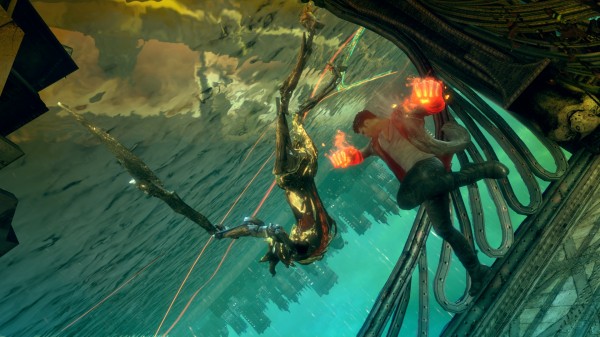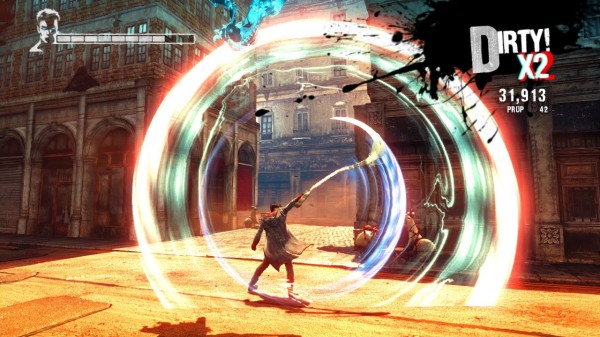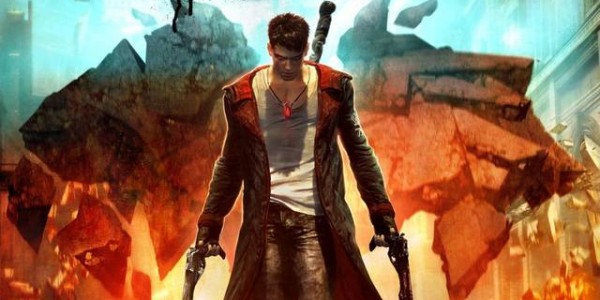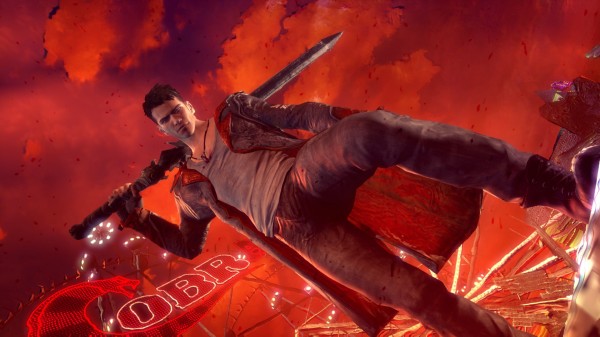Dante has never been an honest person. He was all style and motivation, exaggerated more as the Devil May Cry Series series continued, shifting Dante from moody anti-hero to a smarmy sideshow clown. The most genuine Dante appeared in Devil May Cry 3: Dante’s Awakening, an apt title. With the introduction of twin brother Vergil, Dante was given more character to flesh out. The end result was less than cathartic, but there were some strong character moments.
Building off of those moments, Ninja Theory conjured DmC: Devil May Cry, a franchise reboot that delivers a pre-white-hair Dante, all green around the ears but open for growth. He’s re-imagined for the better, malcontent fans or no.
The demon-king Mundus is holding the world in the palm of his hands. The only force stopping him is a supposed terrorist group called The Order. Heading the organization is a now-earnest and fedora-sporting Vergil who is implores Dante to help stop the demon threat rather than belittle him about being unkempt in the hair region. They’re both Nephilim, Vergil explains, demon/angel half-breeds capable of stopping Mundus. Lending a hand is the human Kat, whose one-on-ones with our hero give moments of tense silence in contrast to unneeded noise. To ration these narrative strengths, Kat often uses magic to transport the demon kin to Limbo, a florescent mirror realm of our own world, with incomplete structures and hordes of bad guys.
In this environment, the glitz of DmC:DMC (we’ll just call it DmC) is fully glorious. Pristine jabs and slashes return, laser-pointed. The fluid, noncommittal nature of weapon organization empowers combo enthusiasts with adaptable maneuvers. L2 and R2 are reserved for Dante’s several angel and demon weapons. The demonic weapons are more brutal and sluggish. The angelic weapons, meanwhile, dance around enemies, offering a wider range of attack in trade for less damage. In the default slot is Dante’s blade, coupled with the returning Ebony and Ivory handguns.
 It’s a focused mayhem seasoned with a wub-wub soundtrack in favor of the usual Pontiac Firebird dread rock, a long-time series staple. What’s missing is the infamous difficulty. Death isn’t nearly as big of a consequence as it once was, and the useful boost from items feels like cheating. I played the game on the default difficulty. If you’re looking for the old-school challenge, go for a something higher. Enemies – especially the bosses – don’t require as much finesse as they did in the past. Combos are less compulsory and more a hobby. It’s a missed opportunity, too, since any skill points divvied out to weapons can be returned and redistributed.
It’s a focused mayhem seasoned with a wub-wub soundtrack in favor of the usual Pontiac Firebird dread rock, a long-time series staple. What’s missing is the infamous difficulty. Death isn’t nearly as big of a consequence as it once was, and the useful boost from items feels like cheating. I played the game on the default difficulty. If you’re looking for the old-school challenge, go for a something higher. Enemies – especially the bosses – don’t require as much finesse as they did in the past. Combos are less compulsory and more a hobby. It’s a missed opportunity, too, since any skill points divvied out to weapons can be returned and redistributed.
Still, what the game lacks in combat it makes up for in story. Thematically, DmC isn’t breaking any new ground, but the fact that developer Ninja Theory went for something a bit loftier is worth recognition. And while Dante can’t seem to put on clothes without leaping through the air at a slowed speed, the game’s commentary on the media, consumerism, and terrorism warrants real reflection. Energy drinks used as mind control devices. Cable news network – “Just Doing God’s Work” – spouting lies. And at the head of it all is a power-hungry demon, accompanied by a canoodling, loose-skinned monster lady. It’s all very hyperbolic, a la V for Vendetta, but there’s intrigue and human emotion hiding in the background, which is more than I can say about earlier outings in the series.

Solidifying it is Dante’s characterization. As a late-teen/early twenties vagabond, Dante is initially more petulant than previous iterations. He curses, he womanizes, he’s inconsiderate and childish. He’s not interested in Mundus or his plot to kill a buncha people and blahdy-blahdy-blah. Only after a trip down memory lane, reliving faded memories about his mother and father, does Dante becomes engaged. It’s a well-paced segment that sells the arc of an immortal, testosterone hound.
Watching Dante grow, watching him care and defend those around him, is a step in the right direction for this series. Devil May Cry lost its charming red leather jacket by the time next gen consoles came around. He grew as much as he could, so they turned to a more vulnerable, angrier and inexplicably identical protagonist in Devil May Cry 4. When that didn’t take, an overhaul was the next (correct) choice. Time will tell if the series’ bucked trends will continue onward or if it was a one-shot treat. It is telling that, by the end, the characters begin reformatting themselves into familiar, overplayed roles from previous installments. But even if we go back to white hair, red coats, and outrageous cinematics, DmC reveals the heart that was at one time intact.



















